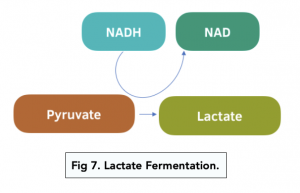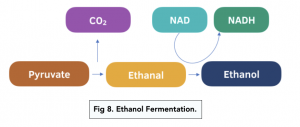Anaerobic Respiration in Mammals, Plants and Fungi (A-level Biology)
Anaerobic Respiration in Mammals, Plants and Fungi
Anaerobic Respiration
There are two steps of anaerobic respiration: glycolysis and fermentation.
Anaerobic respiration is useful. It allows a small amount of ATP to be produced even when there is very little oxygen available.
1. Glycolysis
Let us quickly re-cap glycolysis. For every molecule of glucose, glycolysis produces:
- 2 ATP – 2 ATP were used in step 1, and 4 ATP were made over steps 3 and 4. There is a net production of 2 ATP molecules.
- 2 reduced NAD – 2 molecules of reduced NAD were made in step 3. The reduced NAD will transport hydrogen atoms to the mitochondrial cristae, where they will be used in oxidative phosphorylation.
- 2 pyruvate – 2 molecules of pyruvate are made in step 4.
2. Fermentation
Anaerobic respiration only produces ATP via glycolysis – it doesn’t have other steps for producing ATP, such as oxidative phosphorylation. Therefore step 2 is just about recycling the reduced NAD, to make sure glycolysis can keep happening.
Reduced NAD can be recycled by fermentation, during which it is re-oxidised. There are two types of fermentation:
- Lactate fermentation – this is done in animals and certain bacteria.
- Ethanol fermentation – this is done in fungi, and some plants.
a) Lactate fermentation

- Lactate fermentation often occurs in muscle tissue. During intense exercise, muscle tissue has to use anaerobic respiration due to oxygen shortage. Hence lactate fermentation occurs.
- Pyruvate → lactate. Reduced NAD is oxidised and releases 2 hydrogens, forming NAD. The hydrogens are accepted by pyruvate, and leads to formation of lactate (lactic acid).
- The enzyme lactate dehydrogenase is key. This reaction involves reduction of pyruvate to form lactate. Hence a dehydrogenase enzyme is needed.
- Lactate is broken down in the liver. The key function of the above reaction is to reproduce the NAD, so that it can re-enter glycolysis. The lactate (lactic acid) is transported to the liver, where it is converted back into pyruvate, which is then reused in the link reaction.
- A build of of lactate causes muscle fatigue. If too much lactate builds up then pH falls which can affect enzyme function and therefore lead to fatigue and cramps. Therefore anaerobic respiration isn’t sustainable for long periods of time.

b) Ethanol fermentation

- Ethanol fermentation often occurs in yeast cells. Ethanol fermentation is the equivalent to lactate fermentation, but in yeast cells.
- Pyruvate → ethanol. Reduced NAD is oxidised and releases 2 hydrogens, forming NAD. Pyruvate is decarboxylated, and then reduced to form ethanol.
- Two enzymes are key. Pyruvate decarboxylase is important in decarboxylation of pyruvate, and then ethanol dehydrogenase is important in the reduction of pyruvate.

Anaerobic respiration is a type of cellular respiration that occurs in the absence of oxygen. During anaerobic respiration, cells produce energy through a series of chemical reactions that do not require oxygen.
In mammals, anaerobic respiration occurs in muscle cells during intense physical activity, such as sprinting or weightlifting. When the demand for energy exceeds the supply of oxygen, the cells switch to anaerobic respiration to continue producing energy.
In plants, anaerobic respiration occurs in the roots and other parts of the plant that are submerged in water or have limited access to oxygen. During anaerobic respiration, plants produce energy by breaking down stored sugars and other energy-rich compounds in the absence of oxygen.
In fungi, anaerobic respiration occurs in the absence of oxygen, such as in soil or other environments where oxygen is limited. During anaerobic respiration, fungi produce energy by breaking down organic matter in the absence of oxygen.
The products of anaerobic respiration vary depending on the organism and the type of anaerobic respiration being performed. In mammals, the primary products of anaerobic respiration are lactic acid and ATP (adenosine triphosphate). In plants and fungi, the products of anaerobic respiration can include ethanol, carbon dioxide, and ATP.
Anaerobic respiration has several advantages over aerobic respiration, including the ability to produce energy quickly, the ability to function in environments with limited access to oxygen, and the ability to produce energy from stored sugars and other energy-rich compounds.
Anaerobic respiration has several disadvantages compared to aerobic respiration, including the production of less energy per molecule of glucose, the production of waste products such as lactic acid, and the limited capacity for sustained energy production.
The effects of anaerobic respiration on an organism’s performance depend on the type of organism and the type of anaerobic respiration being performed. In mammals, anaerobic respiration can lead to increased muscle fatigue and decreased performance during intense physical activity, while in plants and fungi, anaerobic respiration can help them adapt to environments with limited access to oxygen.
Anaerobic respiration is studied in biology through a variety of methods, including laboratory experiments, field studies, and computational simulations. By studying anaerobic respiration in different organisms and environments, scientists can gain a better understanding of how cells produce energy in the absence of oxygen and how this process affects the organism’s performance and survival.





Still got a question? Leave a comment
Leave a comment